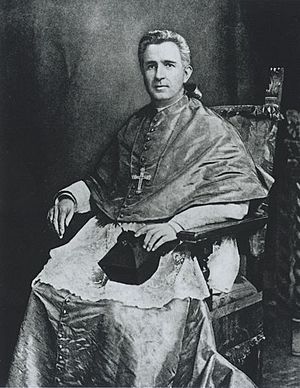Maurice Francis Burke facts for kids
Quick facts for kids Maurice Francis Burke |
|
|---|---|
| Bishop of Saint Joseph | |
 |
|
| See | Diocese of Saint Joseph |
| Predecessor | John Joseph Hogan |
| Successor | Francis Gilfillan |
| Other posts | Bishop of Cheyenne 1887 - 1893 |
| Orders | |
| Ordination | May 22, 1875 |
| Consecration | October 28, 1887 by Patrick Feehan |
| Personal details | |
| Born | May 5, 1845 Knockainy, County Limerick, Ireland |
| Died | May 17, 1923 (aged 78) St. Joseph, Missouri, US |
| Denomination | Roman Catholic |
| Education | University of Saint Mary of the Lake University of Notre Dame Pontifical North American College |
Maurice Francis Burke (May 5, 1845 – March 17, 1923) was an important leader in the Roman Catholic Church. He was born in Ireland and later moved to the United States. He served as a bishop in two different places: first in the Diocese of Cheyenne in Wyoming (from 1887 to 1893), and then in the Diocese of Saint Joseph in Missouri (from 1893 until his death in 1923).
Contents
Maurice Burke's Life
Early Years
Maurice Burke was born on May 5, 1845. His birthplace was Knockainy, a town in County Limerick, Ireland. His parents were Francis Noonan and Joanna (née Casey) Burke.
When Maurice was four years old, his family moved to the United States. They settled in Chicago, Illinois. He went to school at the University of Saint Mary of the Lake in Chicago. He also studied at the University of Notre Dame in Indiana. Later, he continued his studies in Rome, Italy, at the Pontifical North American College.
Becoming a Priest
On May 22, 1875, Maurice Burke became a priest. He was ordained by Cardinal Costantino Patrizi Naro for the Archdiocese of Chicago.
After returning to Chicago, Burke worked as a curate at St. Mary's Parish. A curate is a priest who helps the main pastor. After three years, he became the pastor of St. Mary's Church in Joliet, Illinois.
Bishop of Cheyenne
On August 9, 1887, Pope Leo XIII chose Burke to be the first bishop of a new area. This new area was the Diocese of Cheyenne in Wyoming.
Burke officially became a bishop on October 28, 1887. This special ceremony is called an consecration. Archbishop Patrick Feehan led the ceremony in Chicago.
By 1889, the Cheyenne diocese was very large but had few people. There were only five priests and about 5,000 church members. Bishop Burke also faced problems from a group called the American Protective Association. This group was against Catholics and Irish immigrants. Their strong dislike caused the Sisters of Charity to leave their schools and hospitals in the area.
Bishop Burke traveled to Rome to ask the Pope for help. He wanted the diocese to join a larger, more stable one. He explained how difficult conditions were in Wyoming. However, the Pope did not agree to his request. In a letter, Burke said he felt like a "bishop in name only." He felt he had no one to lead. In 1893, Pope Leo XIII moved the Diocese of Cheyenne to another church region. He also transferred Bishop Burke to a new diocese.
Bishop of Saint Joseph
On June 19, 1893, Pope Leo XIII appointed Burke as the bishop of the Diocese of Saint Joseph in Missouri. This was a new challenge for him.
During his time in Saint Joseph, Bishop Burke did many important things. He paid off a large debt from building the city's main church, called a cathedral. He also built a new home for the bishop and a school for the cathedral's parish. He opened new missions and churches in the area.
Bishop Burke was also known for his knowledge of the Italian writer Dante Alighieri. He even served as the president of the American Dante Society.
Later Life and Legacy
After being sick for three years, Maurice Burke passed away on May 12, 1923. He was 77 years old. He died in St. Joseph, Missouri.
Bishop Burke had a large collection of 3,000 books. After his death, these books were given to the Catholic University of America in Washington, D.C.

